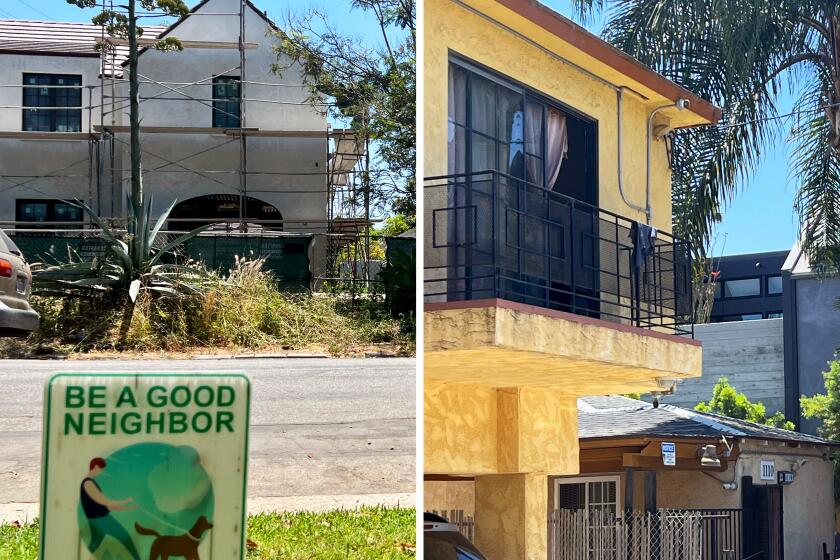This Supreme Court case from California could ease housing shortages everywhere

- Share via
On Jan. 9, the U.S. Supreme Court will hear the case of Californian George Sheetz, who applied for a permit to put a manufactured house on his land in El Dorado County and got hit with a $23,420 traffic mitigation fee. Objecting to the lack of any connection between the dollar amount and his family’s actual impact on traffic in the area, Sheetz paid the fee but turned to the legal system. Sheetz vs. County of El Dorado, California, addresses just a small piece of the state’s housing crisis. Nonetheless, it will matter for millions of people unable to find affordable homes here and in many other states.
When “impact fees” are unmoored from the increased costs a city or county will incur because of a new house or development, the fees can do more than present someone with an unfair bill — they can also reduce housing construction. In a country where a shortage of homes has led to sky-high prices, this matters more than you might think.
The city might make permanent a directive from Mayor Bass that streamlines development. But in its current form, the policy threatens to make low-income Angelenos homeless.
Developers should pay their fair share, of course. If construction fees fail to cover the costs of the increased public services required by new development, elected officials and voters turn to other means to cover or avoid those costs. They may impose growth restrictions or other exclusionary zoning policies to block the building of new homes rather than accept projects that lead to higher taxes or degraded services.
We see pervasive evidence of this happening when localities adopt rules such as single-family zoning, minimum lot-size requirements and aesthetic requirements that ensure that only expensive housing, which generates higher property taxes, can be built.
Properly set impact fees offer a way for development to pay its way, and they reduce political pressure against necessary growth. Local studies have found that appropriately set fees are associated with increased construction in suburban areas.
Studies, and my Venice neighborhood, offer proof: Below-market rents in the corner apartment building don’t preclude a pricey mansion across the street.
But when fees are set at arbitrarily high levels, they disincentivize new home building and add to the country’s housing affordability challenges, causing strain for renters and new home buyers.
In 2013, the Supreme Court held that all permit fees must have an essential connection to the actual impact of a development on city or county services, and a roughly proportional price tag. This sensibly reduces the risk that fees will choke off development.
In some states, such as Florida, jurisprudence goes even further, requiring that fees fund only infrastructure that serves the specific developments they were levied on. Not coincidentally, Florida has seen its population grow more than twice as fast as the country as a whole, reflecting its openness to new homes and relatively fair prices compared with much of the rest of the country.
When unhoused people in San Francisco received $750 a month in an experiment, how did they spend it? The answers challenge our worst assumptions.
But in other states, including California, Maryland, Washington and Arizona, courts have carved out an exception to the Supreme Court’s proportionality principle, allowing higher fees if they are set by legislation. Sheetz’s case will test whether that exception is constitutional.
Part of the rationale for the carve-out is that voters have a remedy against excessive assessments at the ballot box. In theory, they can vote out the lawmakers who are responsible.
However, any claim that voters can and will actually do this is dubious. Housing developers are a small share of any electorate. Future home buyers or renters — those who need municipalities to incentivize, not discourage, home building — may not even vote or live in the jurisdiction when the fees are determined. On the other hand, the people who do vote are likely to be those who already own homes nearby, and they tend to resist growth: Their property increases in value if high fees keep the housing supply low.
Across L.A. County, eviction cases increased by thousands as the pandemic-era moratoriums were lifted. But with other new protections, the numbers did not soar as much as some feared.
The housing affordability crisis is real. Californians in particular should understand the simple calculus of supply and demand that is exacerbating homelessness and causing seven cities (or metro areas) in the state to rank among the 10 most expensive in the nation, according to U.S. News and World Report. When and where state courts allow local politicians to cater to their wealthiest constituents, charge exorbitant impact fees and otherwise keep out new homes, the situation won’t improve.
The Supreme Court is expected to issue a ruling on the El Dorado County fees in the first half of 2024. The legal case that all impact fees, no matter who sets them, should be subject to the same conditions is strong. And during a nationwide housing crisis, the economic case against state and local practices that worsen housing affordability and impede needed housing production is even stronger.
Charles Gardner is an attorney and research fellow with the Mercatus Center at George Mason University. Emily Hamilton is a director of Mercatus’ Urbanity Project.
More to Read
A cure for the common opinion
Get thought-provoking perspectives with our weekly newsletter.
You may occasionally receive promotional content from the Los Angeles Times.













